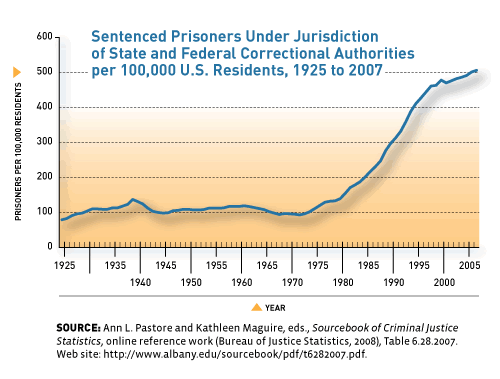How Can We Help Ex-Prisoners Reenter the Labor Market?
From the 1920s to the mid-1970s in this country, the prison population remained steady, with about 110 prison inmates for every 100,000 Americans. In the years since, however, that population has increased nearly fivefold, with more than 500 out of 100,000 U.S. residents in prison by 2007 — or nearly 1.6 million people, not including the approximately 780,000 who are in local jails. From 2000 to 2007, growth in the number of sentenced prisoners in this country also outpaced the growth of the U.S. resident population, rising 15 percent versus 6.4 percent, respectively.
What do these numbers mean? Each year, roughly 700,000 people are released from prison in the United States, and they face daunting challenges to reentering society. About two-thirds are rearrested, and half will return to prison within three years. A large proportion are reincarcerated for technical violations of parole, rather than for new crimes. These numbers are represented disproportionately among minorities and low-income populations, with devastating consequences for their families, their communities, and society at large. Yet, while securing steady employment is one of the central challenges that ex-prisoners face, they are legally barred from working in certain occupations, and many employers are reluctant to hire them.

Given the urgency of this scenario — and given annual corrections costs to state and local governments of roughly $65 billion — helping ex-prisoners return to society is critical. But evidence is needed to show which reentry initiatives are effective. With that in mind, MDRC, in partnership with the Urban Institute and others, is evaluating the Center for Employment Opportunities (CEO), a program for ex-prisoners that is one of four sites in the U.S. Department of Health and Human Services’ Enhanced Services for the Hard-to-Employ Evaluation and Demonstration Project. The program provides ex-prisoners with job-readiness training, followed by placement in temporary, minimum-wage jobs. Within weeks, they receive help finding permanent jobs and, later, services to help them stay employed. The two-year findings of the evaluation — which is measuring the program’s impact on employment, recidivism, and other outcomes — are available in MDRC’s new report, Transitional Jobs for Ex-Prisoners. Notably, CEO reduced recidivism during both the first and the second year of the study period — a rare finding in a rigorous evaluation such as this one.
In another project, MDRC is leading an evaluation of the Joyce Foundation’s Transitional Jobs Reentry Demonstration. The evaluation is looking at the effectiveness of transitional employment in providing ex-prisoners with much-needed income in the period just following release, resolving potential workplace problems, and helping participants find and keep permanent employment and stay out of prison.
MDRC is also part of the team led by Social Policy Research Associates that is evaluating the U.S. Department of Labor’s Reintegration of Ex-Offenders (RExO) Random Assignment Evaluation, which is testing programs designed to increase employment and reduce recidivism among ex-prisoners through the provision of job readiness, job placement, mentoring, and other services.
Sources
Gordon Berlin, “Poverty and Philanthropy” (New York: MDRC, 2008).
“Building Knowledge About Successful Prisoner Reentry Strategies,” MDRC Issue Focus (New York: MDRC, 2008).
Pamela K. Lattimore and Christy A. Visher, “Assessment of the Serious and Violent Offender Reentry Initiative,” Prepared Remarks before the United States House of Representatives Appropriations Subcommittee on Commerce, Justice, Science and Related Agencies (RTI International and the Urban Institute, March 2009).
Ann L. Pastore and Kathleen Maguire, eds., Sourcebook of Criminal Justice Statistics, online reference work (Bureau of Justice Statistics, 2008), Table 6.28.2007.
“Summary Findings,” Prison Statistics (U.S. Department of Justice, Bureau of Justice Statistics, June 30, 2008).
Heather C. West and William J. Sabol, “Prisoners in 2007,” Bureau of Justice Statistics Bulletin (Washington, DC: U.S. Department of Justice, Office of Justice Programs, December 2008).






